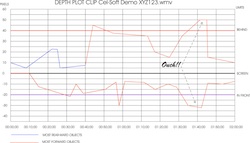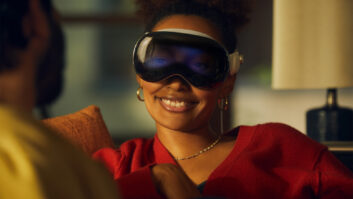
A new addition to the Cel-Scope3D stereoscopic analyser will be introduced by Cel-Soft at BVE 2011 in London (15-17 February).
The automatic logging option will generate a printable report of depth budget and depth plot for easy reference by cameramen during a shoot or by editors during 3D post-production.
“A depth chart is essential for all but the shortest 3D productions,” explains Cel-Soft Managing Director, Robin Palmer. “Creating such charts manually is tedious and time-consuming as the stereographer needs to go through each scene and measure the disparity range used for the principal foreground and background objects and points of attention. These must then be marked as coloured lines on a paper chart against timecode. The reason is to prevent jump cuts that are visually objectionable even if within the actual depth budget.
“An example would be three short scenes where the front-most object in shot one is not present at all in shot two, followed by shot three in which the most front-most object is a lot further back than in shot one. Viewers’ eye muscles must be allowed time to shift attention from one shot to the next. It is also advisable to give viewers opportunities to relax their eyes during the course of a 3D programme. For these and artistic reasons, a depth script needs to be prepared as part of the storyboarding for a big production.”
The new logging option for Cel-Soft’s Cel-Scope3D stereoscopic analyser generates a depth chart automatically. It logs against timecode the maximum and minimum depth values employed, together with the range in use. These measurements can be shown either in percentage of screen width or in horizontal pixels. A cursor can be placed on any object of interest or point of attention for a instant measurement of that spot’s disparity and hence depth.”
Cel-Scope3D is designed for use on set with live inputs as well as for reviewing and playing back 3D media files during post-production. Available as a complete system or as Microsoft Windows-compatible software, it allows stereoscopic camera alignment to be performed quickly; ensuring 3D is accurate from the moment of capture. Footage and edits in a wide range of file formats can be viewed and assessed in real time. Disparities are analysed and displayed as intelligible graphics on 2D or 3D monitors. Anaglyph display, touch-screen control and auto-alarm are all supported.
Cel-Scope3D displays can be scaled and arranged as six or eight windows on one or two PC monitors and on a 3D monitor. Left and right channels can be viewed simultaneously together with actual depth dynamics. Each display window can be set to show waveform, vectorscope and histogram graphics as well as differences in video parameters between each channel. Geometry issues can be identified easily using built-in real-time image manipulation. Quality-control tests can be performed on live stereoscopic video sources in any SD, HD or 2K format from industry standard capture cards or FireWire inputs, or alternatively from file playback.






